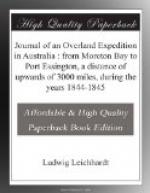A thunder-storm from the north-east, compelled us to hasten into camp; and we had scarcely housed our luggage, when heavy rain set in and continued to fall during the first part of the night.
Nov. 24.—We travelled about nine miles to the north-west, to lat. 13 degrees 5 minutes 49 seconds, which a clear night enabled me to observe by a meridian altitude of Castor. We were, according to my latitude, and to my course, at the South Alligator River, about sixty miles from its mouth, and about one hundred and forty miles from Port Essington.
The river gradually increased in size, and its bed became densely fringed with Pandanus; the hollows and flats were covered with groves of drooping tea-trees. Ridges of sandstone and conglomerate approached the river in several places, and at their base were seen some fine reedy and rushy lagoons, teeming with water-fowl. A flock of black Ibises rose from a moist hollow; white and black cockatoos, were seen and heard frequently. At day-break, I was struck with the sweet song of Rhipidura flaviventris, Gould.
The natives cooeed from the other side of the river, probably to ascertain whether we were friendly or hostile; but did not show themselves any farther. They were Unio eaters to a great extent, judging from the heaps of shells we saw along the river; the species of Unio on which they lived, was much smaller than that we had observed on the Roper. John and Charley saw a native in the bed of the river, busily employed in beating a species of bark, very probably to use its fibres to strain honey. He did not interrupt his work, and either did not see them, or wished to ignore their presence. The horse flies began to be very troublesome, but the mosquitoes fortunately did not annoy us, notwithstanding the neighbourhood of the river, and the late rains. Charley and Brown shot five geese, which gave us a good breakfast and luncheon.
A strong breeze from the northward set in late every afternoon, since we had descended into the valley of the South Alligator River.
Nov. 25.—We travelled about seven miles and a half N.W. by W., to lat. 13 degrees 0 minutes 56 seconds. I intended to follow the sandy bergue of the river, but a dense Pandanus brush soon compelled us to return, and to head several grassy and sedgy swamps like those we passed on the last stage. Chains of small water-holes, and Nymphaea ponds, ran parallel to the river; and very extensive swamps filled the intervals between rather densely wooded ironstone ridges, which seemed to be spurs of a more hilly country, protruding into the valley of the river. Some of these swamps were dry, and had a sound bottom, allowing our cattle to pass without difficulty. Others, however, were exceedingly boggy, and dangerous for both horse and man; for Charley was almost suffocated in the mud, in attempting to procure a goose he had shot. The swamps narrowed towards the river, and formed large and frequently rocky water-holes,




